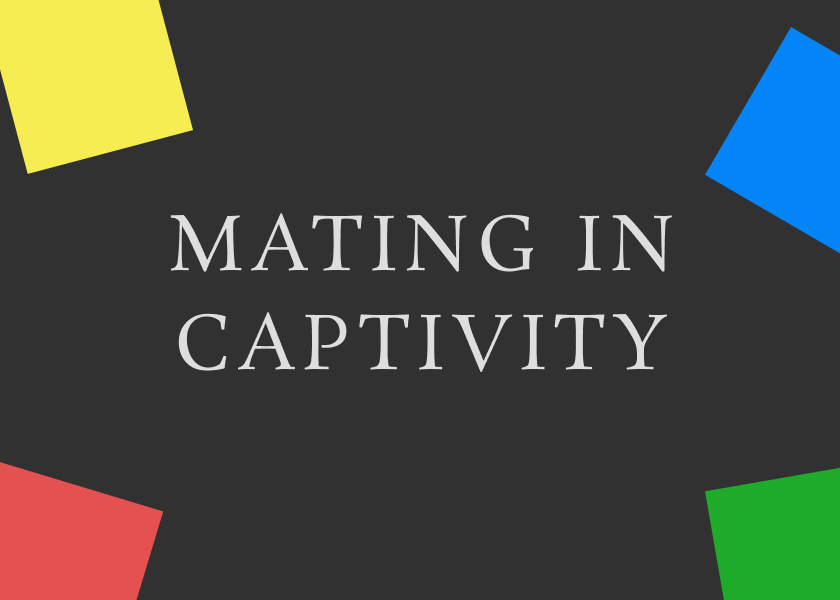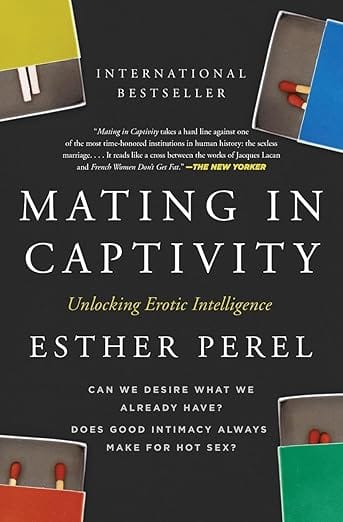Mating in Captivity by Esther Perel - Summary
This book explores why passion often fades in long-term relationships despite enduring love. She argues that too much closeness can diminish desire, and she challenges the idea that communication is the only path to connection. Maintaining mystery and separateness is crucial to a long-term love.

The following is a summary of the book Mating in Captivity by Esther Perel.
Listen to ShelfHelp's podcast summarising the book Mating in Captivity.
Introduction
Is it possible to maintain the spark of passion in a long-term relationship? Many couples find that the initial excitement fades over time, leaving them wondering what went wrong. In Mating in Captivity: Sex, Lies, and Domestic Bliss, Esther Perel, a renowned couples and family therapist, tackles this very question. This book is popular because it delves into the complexities of desire and intimacy, offering a fresh perspective on why passion often diminishes in long-term relationships. This article provides a comprehensive summary, saving you time while highlighting actionable insights that can help you improve your love life.
Table of Contents
- About the Author
- Who Should Read This Book?
- Key Insights and Themes
- Detailed Summary
- Review
- Actionable Takeaways
- FAQs
- Conclusion
About the Author
Esther Perel is a couples and family therapist recognised as a leading authority on erotic intelligence. Born in Belgium, she holds degrees from the Hebrew University of Jerusalem and Lesley College. She also serves on the faculties of the Department of Psychiatry at New York University Medical School and the International Trauma Studies Program at Columbia University. "Mating in Captivity" is her first book, which has garnered international acclaim and has been translated into thirteen languages. Her multicultural background and experience as a therapist provide a unique and insightful perspective on the challenges of modern relationships.
Who Should Read This Book?
This book is essential reading for anyone interested in understanding the dynamics of long-term relationships. Specifically, it will benefit:
- Couples struggling with a decline in sexual desire: If you've noticed that the passion has faded in your relationship, this book provides insights into why this happens and what you can do to rekindle it.
- Individuals seeking to balance intimacy and desire: If you feel like the need for closeness is hindering your sexual life, Perel offers ways to create the emotional and physical space needed for desire to flourish.
- People curious about the interplay of love and eroticism: Whether you are single or partnered, this book offers a thought-provoking analysis of how love and desire interact, which can enrich your understanding of human relationships.
- Therapists and counselors: Professionals will find the book’s blend of theory and real-life examples invaluable for helping couples navigate the complexities of intimacy and passion.
- Those who want a more nuanced understanding of relationships: The book challenges conventional thinking about modern relationships, offering a fresh, and sometimes provocative perspective.
Key Insights and Themes
Here are the key takeaways from Mating in Captivity:
- The Paradox of Intimacy: The pursuit of closeness can paradoxically diminish desire, as the need for security and predictability often clashes with the need for novelty and excitement.
- The Importance of Distance: Creating emotional and physical space within a relationship is crucial for maintaining eroticism. This separateness allows for mystery and the "otherness" that fuels desire.
- Challenging Modern Intimacy: Modern intimacy emphasizes constant communication, which may not be the only way to create genuine connection. Non-verbal forms of intimacy can be as important, such as shared experiences and quiet moments.
- The Role of Fantasy: Exploring and embracing personal fantasies, even those that seem unconventional or taboo, can be a pathway to understanding your own sexuality and desires.
- The Limits of Egalitarianism: While equality is essential in relationships, it doesn't always translate well in the bedroom. The book discusses how sometimes embracing power imbalances within a safe context can be erotic.
- The Myth of Spontaneity: In long term relationships, passion doesn't just happen; it requires intention and effort.
- The Impact of Childhood: Early experiences of love and intimacy significantly shape how we experience desire and relationships as adults.
- The Third Element: Relationships don't exist in a vacuum. The presence of a third element - whether an affair, a fantasy, or the recognition of another person outside the relationship - can change a relationship.
- Reconciling Opposing Needs: Sustaining desire requires navigating the tension between the need for security and the longing for adventure.
Detailed Summary
The book is organised around the exploration of how to maintain desire in long term relationships. It is divided into 11 chapters, each tackling the various aspects of the core problem:
- From Adventure to Captivity: Why the Quest for Security Saps Erotic Vitality: Perel introduces the core conflict between the need for security and the need for adventure. She argues that modern relationships attempt to fulfil both needs, but it is often difficult to achieve both with the same person.
- More Intimacy, Less Sex: Love Seeks Closeness, but Desire Needs Distance: This chapter explores the paradox that the desire for constant closeness can diminish sexual desire. It emphasises the need for creating emotional space to allow for longing and anticipation.
- The Pitfalls of Modern Intimacy: Talk Is Not the Only Avenue to Closeness: Perel challenges the idea that verbal communication is the primary way to achieve intimacy. The book points out that while it is important to talk, there are other important ways to be intimate that may be overlooked.
- Democracy Versus Hot Sex: Desire and Egalitarianism Don’t Play by the Same Rules: This chapter examines how the principles of equality, while essential for a healthy partnership, may not always translate to the realm of eroticism. The book also explores the idea that an imbalance of power in the bedroom can be a source of excitement.
- Can Do! The Protestant Work Ethic Takes On the Degradation of Desire: The book critiques the American "can-do" attitude, which views declining desire as a problem that can be solved through hard work and planning. Perel argues that passion cannot be forced or scheduled and that some problems do not have neat solutions.
- Sex Is Dirty; Save It for Someone You Love: When Puritanism and Hedonism Collide: This chapter explores how cultural ambivalence about sex and pleasure affects people's ability to embrace their sexuality. The book discusses how shame and anxiety can inhibit erotic expression.
- Erotic Blueprints: Tell Me How You Were Loved, and I’ll Tell You How You Make Love: This chapter explores how early experiences in families shape our adult approach to love, sex and relationships. These early experiences create a blueprint for relationships, and these can be difficult to recognise.
- Parenthood: When Three Threatens Two: The book examines how the arrival of children can often disrupt the erotic dynamic of a couple. It emphasises the importance of maintaining a sexual identity separate from the role of parent and the need to not rely on children for emotional fulfillment.
- Of Flesh and Fantasy: In the Sanctuary of the Erotic Mind We Find a Direct Route to Pleasure: Perel discusses the function of fantasy as a crucial part of sexuality, and how it can help people explore desires that they may be afraid to share or act out in real life.
- The Shadow of the Third: Rethinking Fidelity: This chapter delves into the complex nature of infidelity, exploring it beyond simple acts of betrayal. The book argues that the presence of a third element can affect any relationship, and that it is important to acknowledge it rather than deny it.
- Putting the X Back in Sex: Bringing the Erotic Home: The final chapter offers practical advice for couples seeking to rekindle eroticism within the context of their existing relationship. It stresses the importance of creating new rituals and actively pursuing desire.
Review
Mating in Captivity is a thought-provoking and insightful book that challenges conventional wisdom about love and desire.
Strengths:
- Unique Perspective: Perel's multicultural background and extensive experience as a therapist provide a fresh and insightful perspective on relationships.
- Combines Theory and Practice: The book weaves together psychological theory and real-life case studies. This makes the content both informative and relatable.
- Challenges Conventional Wisdom: Perel does not shy away from asking difficult questions, forcing readers to rethink their beliefs about love, intimacy, and desire.
- Practical Advice: While the book delves into theoretical concepts, it also offers actionable steps that readers can take to improve their relationships.
- Well-Written: Perel’s writing is clear, engaging, and easy to understand, making complex topics accessible to a wide audience.
Weaknesses:
- Not a Quick Fix: The book does not offer simple or quick solutions, but rather a long-term approach to navigating the complexities of desire.
- Provocative Ideas: Some readers may find certain ideas, particularly those surrounding power dynamics and non-monogamy, challenging or controversial.
- Emphasis on Heterosexual Relationships: Although the author states that the book is about myriad couples, it may seem that the focus is more on heterosexual couples than other couples.
- May Require Introspection: Readers may need to be willing to engage in some introspection to fully benefit from the book.
Actionable Takeaways
Here are some ways to apply the lessons of Mating in Captivity in your own life:
- Create Space: Make an effort to spend time apart from your partner to create a sense of longing. This might include taking separate vacations, pursuing individual hobbies or even just having separate reading time.
- Embrace Mystery: Don’t share everything with your partner. Retain a sense of individuality and surprise to maintain intrigue.
- Explore Your Fantasies: Be open about your fantasies with your partner (or at least with yourself), and explore where they come from.
- Experiment with Roles: Try new roles in the bedroom to challenge established patterns and introduce excitement.
- Prioritise Play: Find ways to incorporate fun and playfulness into your relationship outside the bedroom. This can be anything from trying a new activity together to having a spontaneous date.
- Be Intentional: Instead of waiting for passion to strike, actively plan to create opportunities for intimacy and desire.
- Look Inward: Take time to reflect on your early experiences with love and how they might be influencing your adult relationships.
- Reconsider "The Third": Instead of fearing it, think about ways that elements from outside of your relationship may change it for the better.
FAQs
- What is "Mating in Captivity" about? "Mating in Captivity" explores why passion often fades in long-term relationships and provides guidance on how to maintain desire and eroticism in the midst of domesticity. The book combines insights from psychology, sociology, and real-life case studies.
- Is "Mating in Captivity" worth reading? Yes, "Mating in Captivity" is worth reading if you are looking for a fresh perspective on love and desire. The book will challenge your assumptions and encourage you to think about your own relationships in a more nuanced way.
- Does Esther Perel offer solutions? Rather than providing quick fixes, the book encourages readers to embrace the paradoxes of long-term love and to understand the complexities of desire. It offers actionable insights and advice.
- Is this book only for couples? No, although the book focuses on couples, individuals can also benefit from its exploration of desire, intimacy, and the dynamics of human relationships.
Conclusion
Mating in Captivity is a groundbreaking exploration of the complex dynamics of love and desire in modern relationships. By challenging conventional ideas and offering practical insights, Esther Perel provides a valuable resource for anyone seeking to understand and improve their relationships. It is a book that encourages you to embrace the contradictions of love, to find the erotic within the everyday, and to actively cultivate desire rather than passively wait for it to appear. Don't settle for a passionless relationship; start reading and take the first step towards a more fulfilling and exciting love life today.
As an Amazon Associate, ShelfHelp may earn money from qualifying purchases. Needless to say, ShelfHelp only includes affiliate links to books we recommend and think are worth your time reading.




